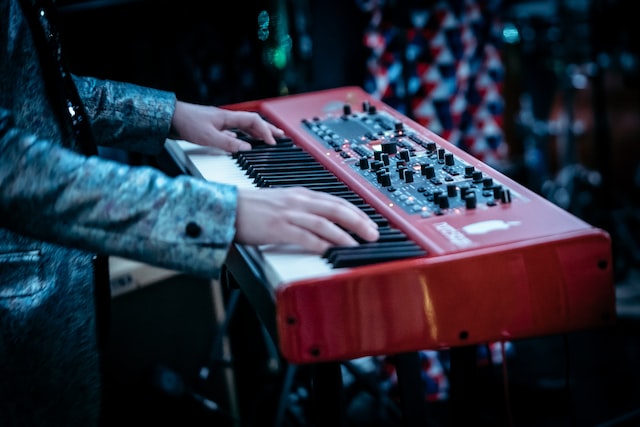How is a keyboard instrument different from a workstation? Basically – nothing, the sound shaping chain is the same anyway: keyboard, tone generator, effects processor. However, additional functional blocks such as sequencer or harmony and form factor separate these devices quite clearly into categories.
Besides the midi-keyboard, there are several other devices that work on the same principle, that is, electronic keyboards. Let’s try to understand the nuances of this technique.
Digital piano
A digital piano is the simplest keyboard device in terms of electronics: a minimal assortment of timbres, simple effects for imitating the sound of a hall. All efforts in creating such instruments are aimed at neutralizing the difference in feel from playing them and traditional acoustic pianos. This is facilitated by a weighted 7-octave hammer action keyboard and a solid floor body with classic pedals. The digital piano also most often has a cover to keep dust out of the keys, and a music rest, which is a music stand. The price of an instrument equipped with a full keyboard and an acceptable tone generator usually does not go below two thousand dollars.
However, in a concert grand piano, the timbre also changes slightly from note to note, since the strings differ in number (three strings per note at the top, one in the bass), braiding material, length, and also the weight of the hammer. It also recreates resonances when the pedal or other keys are pressed, and the natural decay of notes when the pedal is not fully pressed.
Midi keyboard
A MIDI keyboard is a keyboard-type instrument that is only used to record parts of other instruments. It also allows you to quickly control the software used to process the received audio data. A laptop or stationary computer is used as a connecting link.
Some users are mistaken that MIDI can be used separately from the recording system. However, the keyboard will not sound unless you connect it to your computer.
A distinctive feature of MIDI is the absence of timbres and built-in effects, as well as speakers that could play sound. Therefore, a connection to a PC is required. Also, the keyboard is configured through the software.
The advantage of midi keyboards is that they have digital input and output functions. This eliminates the need for a separate audio interface when used as a digital audio workstation. But for live performance, a synthesizer with outputs for mixers, amplifiers and speakers is more suitable.
The smallest MIDI keyboards and synthesizers have only 25 keys, while full-size digital pianos and organs can be operated with 88 keys. The right choice for you depends on how much space you have to place the keyboard, its portability, and the music you plan to play.
Synthesizer
A synthesizer is essentially a textbook device that allows you to get the desired sound by pressing the keys. There are no tools for recording the game in synthesizers, as well as other systems that help create a composition. Today synthesizers are used primarily in recording studios and at concerts – for playing live. There are many types of synthesizers, but one thing is clear: they are hardly suitable for the role of a universal home instrument.
Music workstation
The music workstation is potentially the most powerful standalone solution for composers who reject templates and stamps. The stations do not have automatic accompaniment and other means that make it possible to rivet a song quickly and ingeniously. However, in manual mode, you can do almost anything you want. Like the best keyboard arrangers, flagship workstations allow you to create studio-quality compositions, including adding live instrument tracks and vocals (mic input and basic audio processing are available on many models, although the mic itself is not included). A kind of compact home studio “in one box”. The cost of truly outstanding models ranges from 4,000 to 7,000 US dollars, and simpler options are offered for more than 3 thousand dollars.
The workstation combines:
Piano keyboard
Like most keyboards, the music workstation has a full piano-style keyboard.
Drum machine
Sooner or later, you will want to create drum samples. And workstations have ready-to-use solutions on board. In reality, the drum machine is more often presented in a virtual form.
Synthesizer
That is where the signal processing algorithms are loaded, and it is the very node that synthesizes the sound. Maybe without a keyboard, since in this context it is generally a computer program.
Sequencer
The main emphasis is placed on recording, processing and playback of midi messages. In practice, this means that if you do not like the sound of the instrument that you recorded, then you can easily change it and put, for example, instead of the sound of a guitar, the sound of a church organ.
However, for professional work, a computer studio is potentially better in everything (a computer with a monitor, a MIDI keyboard, an audio interface) and licensed software, including sound libraries, then it can be even more expensive than the best keyboard station, and it will be disproportionate in setting up and using more difficult. In this regard, the keyboard station is much more attractive: you can work immediately after plugging into the outlet, there is an instruction with a detailed description of each operation, and using an arsenal of functions is no more difficult than operating a smartphone. But even the best keyboard stations are not suited for active recording of live instruments and processing / editing of such tracks.

